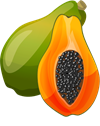
PUMPA - SMART LEARNING
எங்கள் ஆசிரியர்களுடன் 1-ஆன்-1 ஆலோசனை நேரத்தைப் பெறுங்கள். டாப்பர் ஆவதற்கு நாங்கள் பயிற்சி அளிப்போம்
Book Free DemoPacking of items is an everyday action taking place around us, right from packing books and notes in the school bag to packing any items in a box or container, etc.,
Before we pack anything, we must decide the following:
- What to pack?
- How to pack?
- How many items are to be packed?
- How many items fit in the fixed space?
There are two methods used while packing. They are:
- Fractional Method
- Sorting Method
We will discuss the fractional method of packing items.
Fractional method:
While packing the items in a fixed space (boxes or containers etc.,) we will determine the weight, value and the number of each item with the condition that the weight items must be less than or equal to the weight or capacity of the container. This method uses the technique of buying items fractionally in such a way that more items or things are bought within the given budget.
Let us briefly learn the fractional method better from the following situation.
Situation:
Suppose you want to buy the following list of fruits that is required for a week. The bag you have has a capacity of \(10\) \(kg\). The objective is to buy more fruits and vegetables within your budget of \(₹\) \(1400\) with the condition that the weight does not exceed \(10\) \(kg\).
- Apple \(-\) \(3\) \(kg\)
- Papaya \(-\) \(2\tfrac{1}{2}\) \(kg\)
- Watermelon \(-\) \(4\) \(kg\)
- Guava \(-\) \(2\) \(kg\)
- Grapes \(-\) \(1\tfrac{1}{2}\) \(kg\)
For instance, let the price list of the fruits you want to buy is as follows:
Fruit Name | Fruit | Weight | Price |
Apple |  | \(1 kg\) | \(₹\)\(180\) |
Papaya |  | \(1 kg\) | \(₹\)\(120\) |
Watermelon |  | \(1 kg\) | \(₹\)\(100\) |
Guava |  | \(1 kg\) | \(₹\)\(130\) |
Grapes |  | \(1 kg\) | \(₹\)\(80\) |
Let us tabulate the fruits with their weights and the price you want to buy as follows:
Fruit name | Fruit | Required quantity | Price of required fruits | Price |
Apple |  | \(3 kg\) | Cost of \(1\) \(kg\) of apples \(=\) \(₹\)\(180\) Cost of \(3\) \(kg\) of apples \(=\) \(3 \times 180\) \(=\) \(₹\)\(540\) | \(₹\) \(540\) |
Papaya |  | \(2\tfrac{1}{2}\) \(kg\) | Cost of \(1\) \(kg\) of papayas \(=\) \(₹\)\(120\) Cost of \(2\tfrac{1}{2}\) \(kg\) of papayas \(=\) \(\frac{5}{2} \times 120\) \(=\) \(₹\)\(300\) | \(₹\) \(300\) |
Watermelon |  | \(4\) \(kg\) | Cost of \(1\) \(kg\) of watermelon \(=\) \(₹\)\(100\) Cost of \(4\) \(kg\) of watermelon \(=\) \(4 \times 100\) \(=\) \(₹\)\(400\) | \(₹\) \(400\) |
Guava |  | \(2\) \(kg\) | Cost of \(1\) \(kg\) of guavas \(=\) \(₹\)\(130\) Cost of \(2\) \(kg\) of guavas \(=\) \(2 \times 130\) \(=\) \(₹\)\(260\) | \(₹\) \(260\) |
Grapes |  | \(1\tfrac{1}{2}\) \(kg\) | Cost of \(1\) \(kg\) of grapes \(=\) \(₹\)\(80\) Cost of \(1\tfrac{1}{2}\) \(kg\) of grapes \(=\) \(\frac{3}{2} \times 80\) \(=\) \(₹\)\(120\) | \(₹\) \(120\) |
Approach \(I\): Selecting items with maximum price:
In this approach, we select the items according to the maximum price. Here the maximum cost is \(₹\) \(540\). Let us tabulate and find the total price and the quantity of fruits that can be bought within our budget of \(₹\) \(1400\) and not exceeding \(10\) \(kg\).
Ordering of fruits based on maximum price:
Fruit name | Fruit | Price \(₹\) | Weight \(kg\) | Remaining weight to buy |
Apple |  | \(540\) | \(3\) | \(=\) \(10 - 3\) \(=\) \(7\) |
Watermelon |  | \(400\) | \(4\) | \(=\) \(7 - 3\) \(=\) \(4\) |
Papaya |  | \(300\) | \(2\tfrac{1}{2}\) | \(=\) \(3 - 2\tfrac{1}{2}\) \(=\) \(\frac{1}{2}\) |
Guava |  | \(260 \times \frac{1}{4} = 65\) | \(\frac{1}{2}\) | \(=\) \(\frac{1}{2}\) \(-\) \(\frac{1}{2}\) \(=\) \(0\) |
Total | \(1305\) | \(10\) \(kg\) |
Here \(\frac{1}{2}\) \(kg\) of guava is enough as the total weight of the fruits reaches \(10\) \(kg\) which costs \(₹\) \(65\). Hence, in this approach the minimum amount spent is \(₹\) \(1305\) to buy \(10\) \(kg\) of fruits.
Approach \(II\): Selecting items with minimum weight:
In this approach, we select the items according to the minimum weight. Here the minimum weight is \(1\tfrac{1}{2}\) \(kg\). In this approach, we can select more and more items. Let us tabulate and find the total price and the quantity of fruits that can be bought within our budget of \(₹\) \(1400\) and not exceeding \(10\) \(kg\).
Ordering of fruits based on minimum weight:
Fruit name | Fruit | Price \(₹\) | Weight \(kg\) | Remaining weight to buy |
Grapes |  | \(120\) | \(1\tfrac{1}{2}\) | \(=\) \(10 - 1\tfrac{1}{2}\) \(=\) \(8\tfrac{1}{2}\) |
Guava |  | \(260\) | \(2\) | \(=\) \(8\tfrac{1}{2} - 2\) \(=\) \(6\tfrac{1}{2}\) |
Papaya |  | \(300\) | \(2\tfrac{1}{2}\) | \(=\) \(6\tfrac{1}{2} - 2\tfrac{1}{2}\) \(=\) \(4\) |
Apple |  | \(540\) | \(3\) | \(=\) \(4\) \(-\) \(3\) \(=\) \(1\) |
Watermelon |  | \(400 \times \frac{1}{4} = 100\) | \(1\) | \(=\) \(1\) \(-\) \(1\) \(=\) \(0\) |
Total | \(1320\) | \(10\) \(kg\) |
Here \(1\) \(kg\) of watermelon is enough as the total weight of the fruits reaches \(10\) \(kg\) which costs \(₹\) \(100\). Hence, in this approach the minimum amount spent is \(₹\) \(1320\) to buy \(10\) \(kg\) of fruits.
Approach \(III\): Finding the maximum price to weight ratio:
In this approach, we select the items according to the maximum price to weight ratio (find the rate of \(1\) \(kg\)). Let us tabulate and find the total price and the quantity of fruits that can be bought within our budget of \(₹\)\(1400\) and not exceeding \(10\) \(kg\).
Ordering of fruits based on the maximum price to weight ratio:
Fruit name | Fruit | Price of \(kg\) | Price \(₹\) | Weight \(kg\) | Remaining weight to buy |
Apple |  | \(180\) | \(540\) | \(3\) | \(=\) \(10 - 3\) \(=\) \(7\) |
Guava |  | \(130\) | \(260\) | \(2\) | \(=\) \(7 - 2\) \(=\) \(5\) |
Papaya |  | \(120\) | \(300\) | \(2\tfrac{1}{2}\) | \(=\) \(5 - 2\tfrac{1}{2}\) \(=\) \(2\tfrac{1}{2}\) |
Watermelon |  | \(100\) | \(100 \times \frac{5}{2} = 250\) | \(2\tfrac{1}{2}\) | \(=\) \(2\tfrac{1}{2} - 2\tfrac{1}{2}\) \(=\) \(0\) |
Total | \(1350\) | \(10\) \(kg\) |
Here \(2\tfrac{1}{2}\) \(kg\) of watermelon is enough as the total weight of the fruits reaches \(10\) \(kg\) which costs \(₹\)\(250\). Hence, in this approach the minimum amount spent is \(₹\)\(1350\) to buy \(10\) \(kg\) of fruits.
From all the three approaches, approach \(II\) is better as we can buy more items on spending minimum amount.